Decision Making in Organizations: Models, Tools, and Influences Report
VerifiedAdded on 2020/12/26
|13
|3451
|61
Report
AI Summary
This report provides a comprehensive overview of decision-making processes within organizations. It begins by introducing the fundamental concepts of decision-making, highlighting the importance of both large and small decisions. The report then delves into various decision-making models, including rational and non-rational approaches, such as the rational model, intuitive decision-making, satisfying model, incremental model, and garbage-can model. Furthermore, it explores advanced models like the OODA Loop and Vroom's decision-making model. The report also examines a range of decision-making tools and techniques, including the decision matrix, T-chart, decision tree, multi-voting, Pareto analysis, cost-benefit analysis, conjoint analysis, SWOT analysis, and PEST analysis. These tools are presented to equip managers and leaders with the knowledge to evaluate options, analyze situations, and make informed decisions. The report emphasizes the application of these models and tools in real-world business scenarios, providing practical insights for effective decision-making in different organizational contexts.
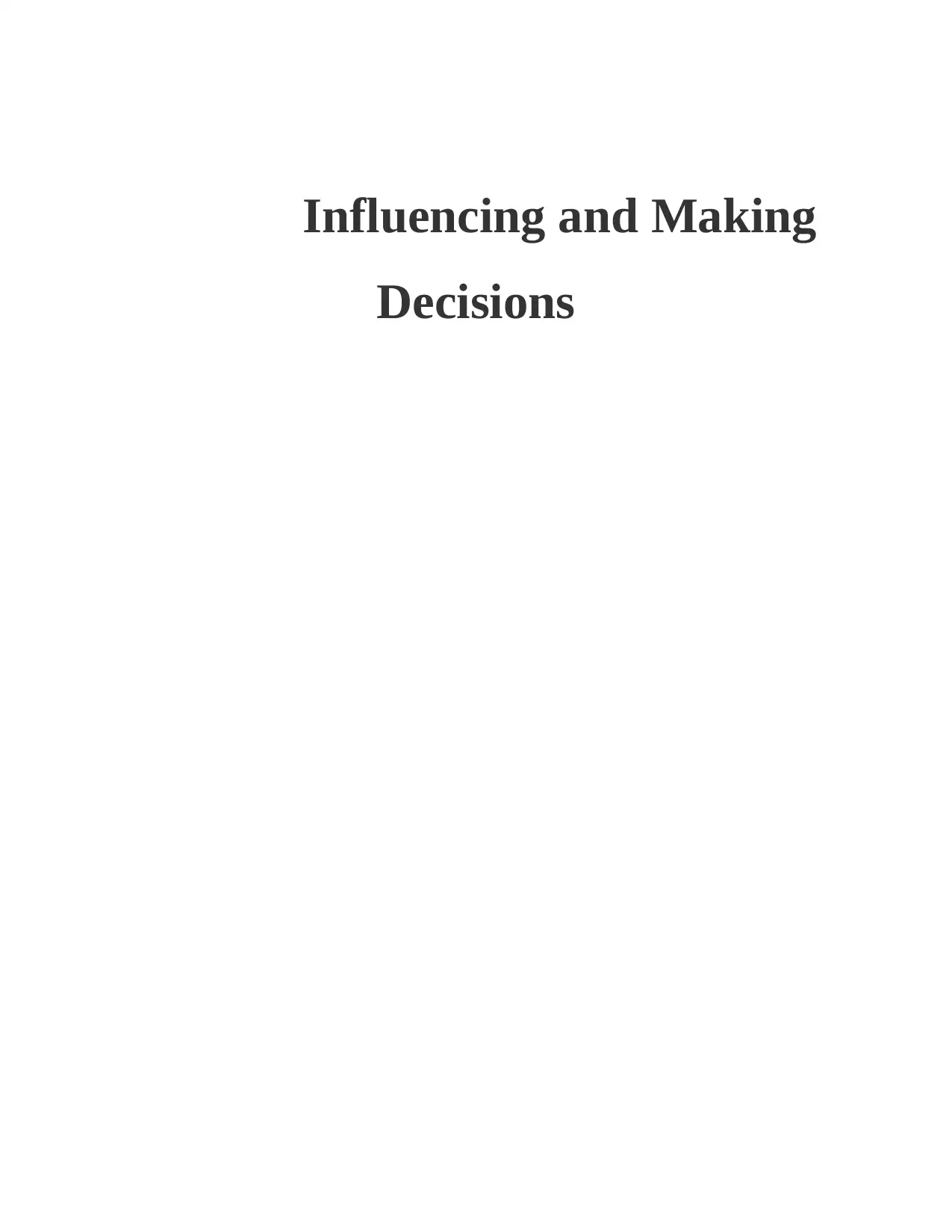
Influencing and Making
Decisions
Decisions
Paraphrase This Document
Need a fresh take? Get an instant paraphrase of this document with our AI Paraphraser
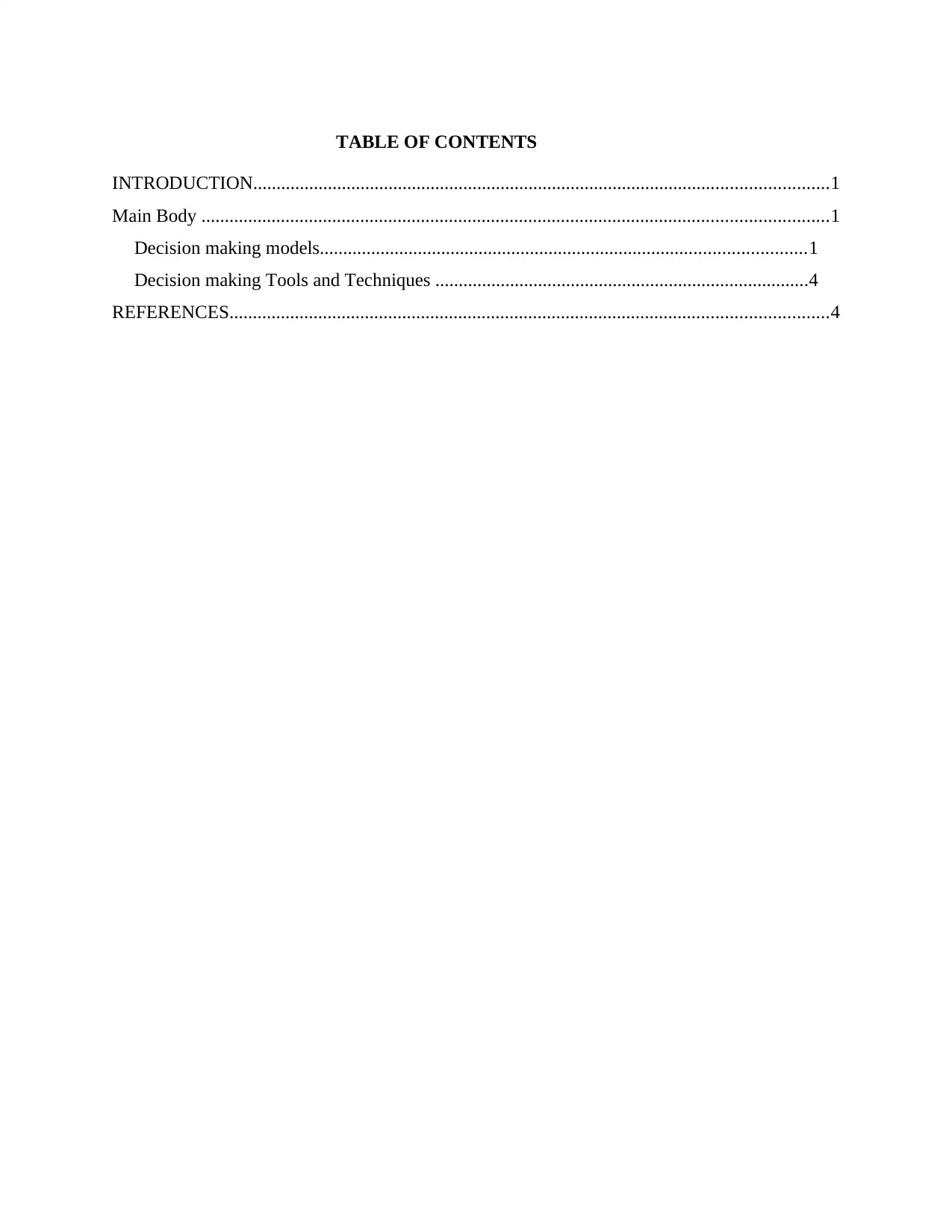
TABLE OF CONTENTS
INTRODUCTION...........................................................................................................................1
Main Body ......................................................................................................................................1
Decision making models........................................................................................................1
Decision making Tools and Techniques ................................................................................4
REFERENCES................................................................................................................................4
INTRODUCTION...........................................................................................................................1
Main Body ......................................................................................................................................1
Decision making models........................................................................................................1
Decision making Tools and Techniques ................................................................................4
REFERENCES................................................................................................................................4
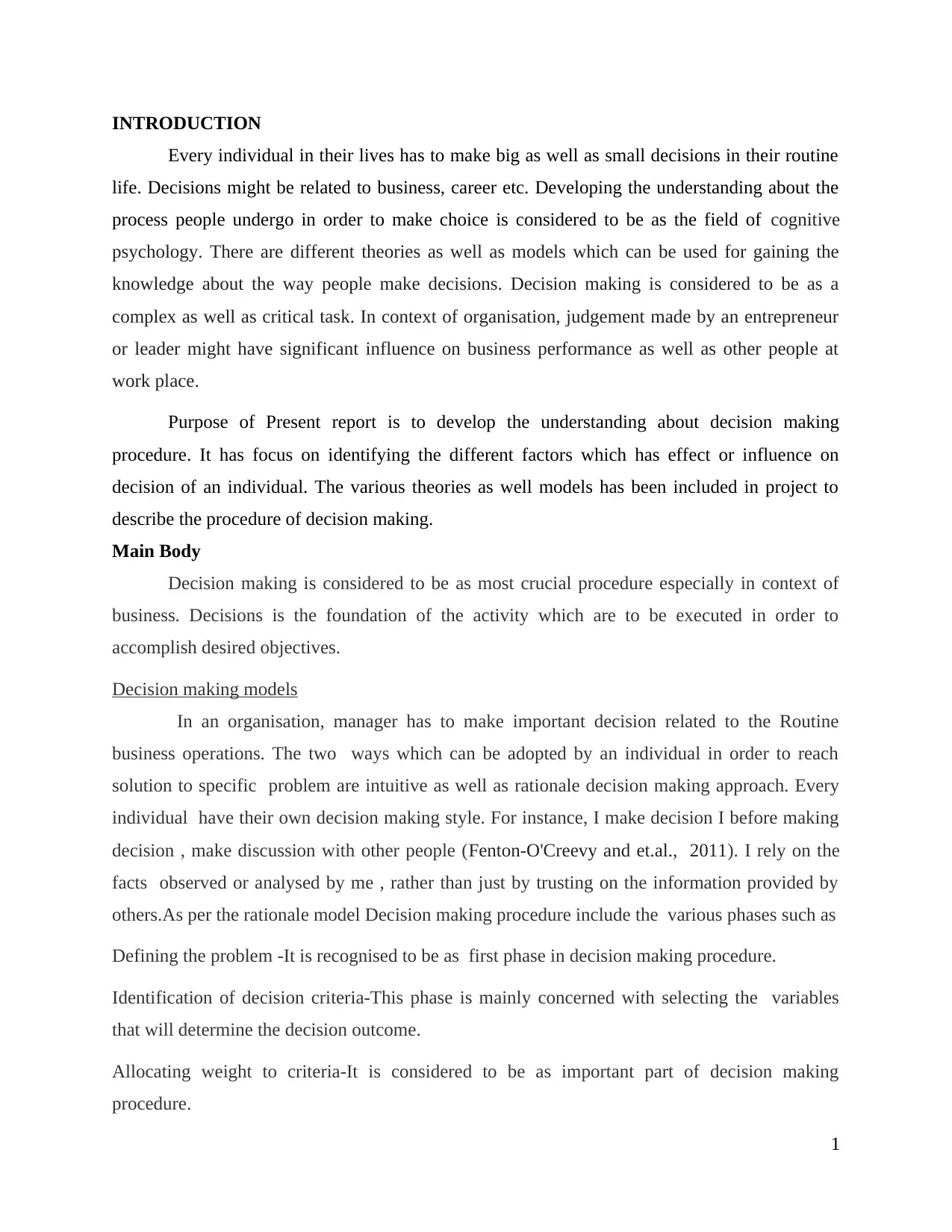
INTRODUCTION
Every individual in their lives has to make big as well as small decisions in their routine
life. Decisions might be related to business, career etc. Developing the understanding about the
process people undergo in order to make choice is considered to be as the field of cognitive
psychology. There are different theories as well as models which can be used for gaining the
knowledge about the way people make decisions. Decision making is considered to be as a
complex as well as critical task. In context of organisation, judgement made by an entrepreneur
or leader might have significant influence on business performance as well as other people at
work place.
Purpose of Present report is to develop the understanding about decision making
procedure. It has focus on identifying the different factors which has effect or influence on
decision of an individual. The various theories as well models has been included in project to
describe the procedure of decision making.
Main Body
Decision making is considered to be as most crucial procedure especially in context of
business. Decisions is the foundation of the activity which are to be executed in order to
accomplish desired objectives.
Decision making models
In an organisation, manager has to make important decision related to the Routine
business operations. The two ways which can be adopted by an individual in order to reach
solution to specific problem are intuitive as well as rationale decision making approach. Every
individual have their own decision making style. For instance, I make decision I before making
decision , make discussion with other people (Fenton‐O'Creevy and et.al., 2011). I rely on the
facts observed or analysed by me , rather than just by trusting on the information provided by
others.As per the rationale model Decision making procedure include the various phases such as
Defining the problem -It is recognised to be as first phase in decision making procedure.
Identification of decision criteria-This phase is mainly concerned with selecting the variables
that will determine the decision outcome.
Allocating weight to criteria-It is considered to be as important part of decision making
procedure.
1
Every individual in their lives has to make big as well as small decisions in their routine
life. Decisions might be related to business, career etc. Developing the understanding about the
process people undergo in order to make choice is considered to be as the field of cognitive
psychology. There are different theories as well as models which can be used for gaining the
knowledge about the way people make decisions. Decision making is considered to be as a
complex as well as critical task. In context of organisation, judgement made by an entrepreneur
or leader might have significant influence on business performance as well as other people at
work place.
Purpose of Present report is to develop the understanding about decision making
procedure. It has focus on identifying the different factors which has effect or influence on
decision of an individual. The various theories as well models has been included in project to
describe the procedure of decision making.
Main Body
Decision making is considered to be as most crucial procedure especially in context of
business. Decisions is the foundation of the activity which are to be executed in order to
accomplish desired objectives.
Decision making models
In an organisation, manager has to make important decision related to the Routine
business operations. The two ways which can be adopted by an individual in order to reach
solution to specific problem are intuitive as well as rationale decision making approach. Every
individual have their own decision making style. For instance, I make decision I before making
decision , make discussion with other people (Fenton‐O'Creevy and et.al., 2011). I rely on the
facts observed or analysed by me , rather than just by trusting on the information provided by
others.As per the rationale model Decision making procedure include the various phases such as
Defining the problem -It is recognised to be as first phase in decision making procedure.
Identification of decision criteria-This phase is mainly concerned with selecting the variables
that will determine the decision outcome.
Allocating weight to criteria-It is considered to be as important part of decision making
procedure.
1
⊘ This is a preview!⊘
Do you want full access?
Subscribe today to unlock all pages.

Trusted by 1+ million students worldwide
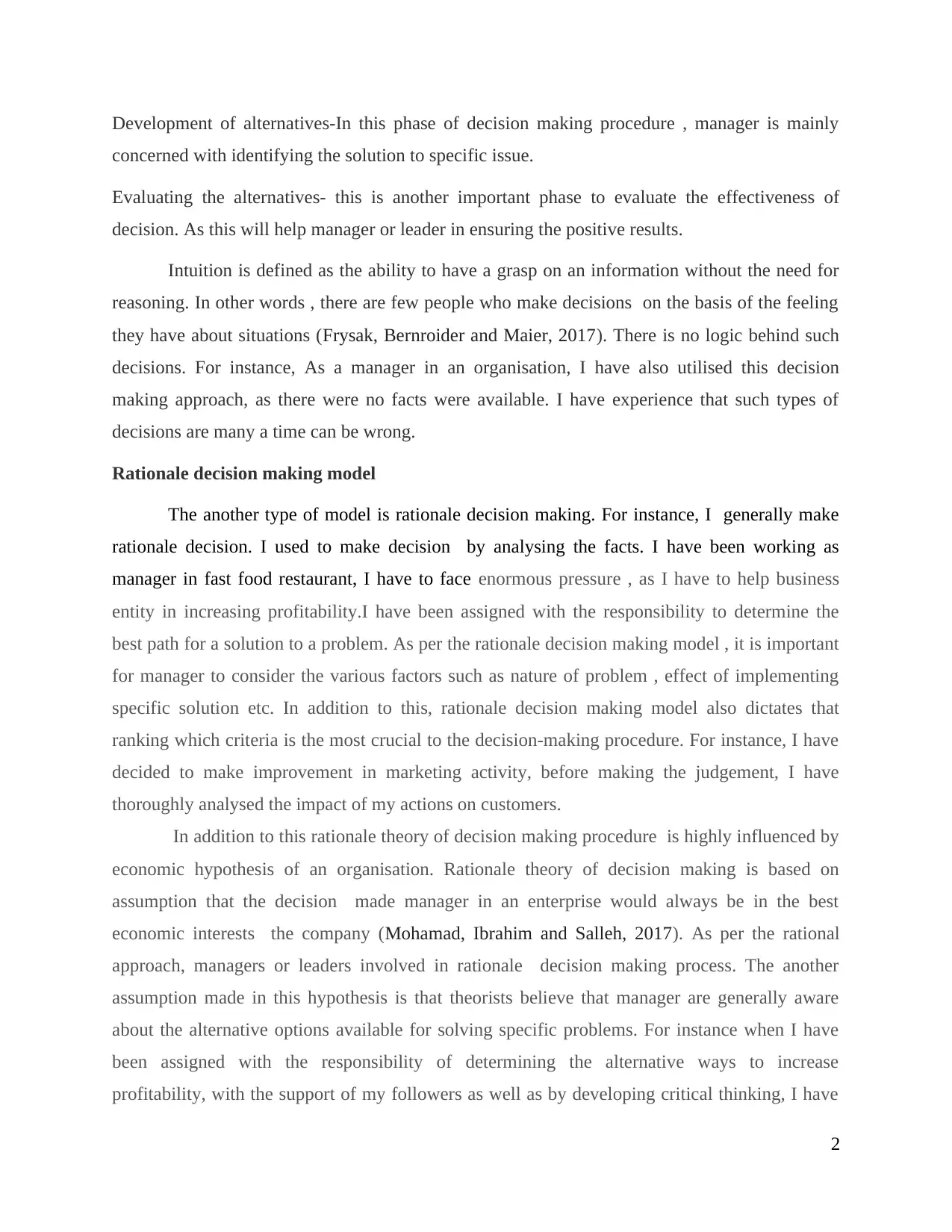
Development of alternatives-In this phase of decision making procedure , manager is mainly
concerned with identifying the solution to specific issue.
Evaluating the alternatives- this is another important phase to evaluate the effectiveness of
decision. As this will help manager or leader in ensuring the positive results.
Intuition is defined as the ability to have a grasp on an information without the need for
reasoning. In other words , there are few people who make decisions on the basis of the feeling
they have about situations (Frysak, Bernroider and Maier, 2017). There is no logic behind such
decisions. For instance, As a manager in an organisation, I have also utilised this decision
making approach, as there were no facts were available. I have experience that such types of
decisions are many a time can be wrong.
Rationale decision making model
The another type of model is rationale decision making. For instance, I generally make
rationale decision. I used to make decision by analysing the facts. I have been working as
manager in fast food restaurant, I have to face enormous pressure , as I have to help business
entity in increasing profitability.I have been assigned with the responsibility to determine the
best path for a solution to a problem. As per the rationale decision making model , it is important
for manager to consider the various factors such as nature of problem , effect of implementing
specific solution etc. In addition to this, rationale decision making model also dictates that
ranking which criteria is the most crucial to the decision-making procedure. For instance, I have
decided to make improvement in marketing activity, before making the judgement, I have
thoroughly analysed the impact of my actions on customers.
In addition to this rationale theory of decision making procedure is highly influenced by
economic hypothesis of an organisation. Rationale theory of decision making is based on
assumption that the decision made manager in an enterprise would always be in the best
economic interests the company (Mohamad, Ibrahim and Salleh, 2017). As per the rational
approach, managers or leaders involved in rationale decision making process. The another
assumption made in this hypothesis is that theorists believe that manager are generally aware
about the alternative options available for solving specific problems. For instance when I have
been assigned with the responsibility of determining the alternative ways to increase
profitability, with the support of my followers as well as by developing critical thinking, I have
2
concerned with identifying the solution to specific issue.
Evaluating the alternatives- this is another important phase to evaluate the effectiveness of
decision. As this will help manager or leader in ensuring the positive results.
Intuition is defined as the ability to have a grasp on an information without the need for
reasoning. In other words , there are few people who make decisions on the basis of the feeling
they have about situations (Frysak, Bernroider and Maier, 2017). There is no logic behind such
decisions. For instance, As a manager in an organisation, I have also utilised this decision
making approach, as there were no facts were available. I have experience that such types of
decisions are many a time can be wrong.
Rationale decision making model
The another type of model is rationale decision making. For instance, I generally make
rationale decision. I used to make decision by analysing the facts. I have been working as
manager in fast food restaurant, I have to face enormous pressure , as I have to help business
entity in increasing profitability.I have been assigned with the responsibility to determine the
best path for a solution to a problem. As per the rationale decision making model , it is important
for manager to consider the various factors such as nature of problem , effect of implementing
specific solution etc. In addition to this, rationale decision making model also dictates that
ranking which criteria is the most crucial to the decision-making procedure. For instance, I have
decided to make improvement in marketing activity, before making the judgement, I have
thoroughly analysed the impact of my actions on customers.
In addition to this rationale theory of decision making procedure is highly influenced by
economic hypothesis of an organisation. Rationale theory of decision making is based on
assumption that the decision made manager in an enterprise would always be in the best
economic interests the company (Mohamad, Ibrahim and Salleh, 2017). As per the rational
approach, managers or leaders involved in rationale decision making process. The another
assumption made in this hypothesis is that theorists believe that manager are generally aware
about the alternative options available for solving specific problems. For instance when I have
been assigned with the responsibility of determining the alternative ways to increase
profitability, with the support of my followers as well as by developing critical thinking, I have
2
Paraphrase This Document
Need a fresh take? Get an instant paraphrase of this document with our AI Paraphraser
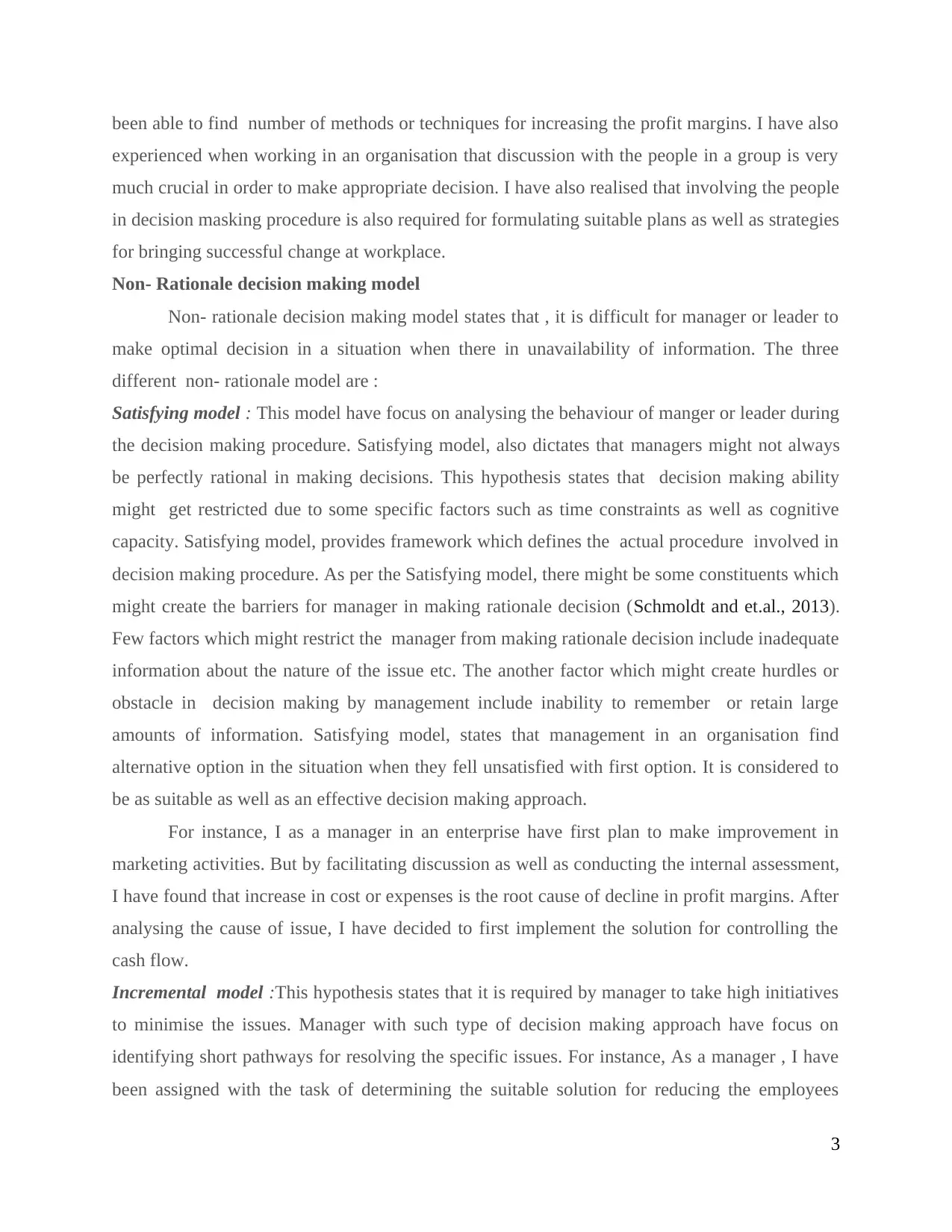
been able to find number of methods or techniques for increasing the profit margins. I have also
experienced when working in an organisation that discussion with the people in a group is very
much crucial in order to make appropriate decision. I have also realised that involving the people
in decision masking procedure is also required for formulating suitable plans as well as strategies
for bringing successful change at workplace.
Non- Rationale decision making model
Non- rationale decision making model states that , it is difficult for manager or leader to
make optimal decision in a situation when there in unavailability of information. The three
different non- rationale model are :
Satisfying model : This model have focus on analysing the behaviour of manger or leader during
the decision making procedure. Satisfying model, also dictates that managers might not always
be perfectly rational in making decisions. This hypothesis states that decision making ability
might get restricted due to some specific factors such as time constraints as well as cognitive
capacity. Satisfying model, provides framework which defines the actual procedure involved in
decision making procedure. As per the Satisfying model, there might be some constituents which
might create the barriers for manager in making rationale decision (Schmoldt and et.al., 2013).
Few factors which might restrict the manager from making rationale decision include inadequate
information about the nature of the issue etc. The another factor which might create hurdles or
obstacle in decision making by management include inability to remember or retain large
amounts of information. Satisfying model, states that management in an organisation find
alternative option in the situation when they fell unsatisfied with first option. It is considered to
be as suitable as well as an effective decision making approach.
For instance, I as a manager in an enterprise have first plan to make improvement in
marketing activities. But by facilitating discussion as well as conducting the internal assessment,
I have found that increase in cost or expenses is the root cause of decline in profit margins. After
analysing the cause of issue, I have decided to first implement the solution for controlling the
cash flow.
Incremental model :This hypothesis states that it is required by manager to take high initiatives
to minimise the issues. Manager with such type of decision making approach have focus on
identifying short pathways for resolving the specific issues. For instance, As a manager , I have
been assigned with the task of determining the suitable solution for reducing the employees
3
experienced when working in an organisation that discussion with the people in a group is very
much crucial in order to make appropriate decision. I have also realised that involving the people
in decision masking procedure is also required for formulating suitable plans as well as strategies
for bringing successful change at workplace.
Non- Rationale decision making model
Non- rationale decision making model states that , it is difficult for manager or leader to
make optimal decision in a situation when there in unavailability of information. The three
different non- rationale model are :
Satisfying model : This model have focus on analysing the behaviour of manger or leader during
the decision making procedure. Satisfying model, also dictates that managers might not always
be perfectly rational in making decisions. This hypothesis states that decision making ability
might get restricted due to some specific factors such as time constraints as well as cognitive
capacity. Satisfying model, provides framework which defines the actual procedure involved in
decision making procedure. As per the Satisfying model, there might be some constituents which
might create the barriers for manager in making rationale decision (Schmoldt and et.al., 2013).
Few factors which might restrict the manager from making rationale decision include inadequate
information about the nature of the issue etc. The another factor which might create hurdles or
obstacle in decision making by management include inability to remember or retain large
amounts of information. Satisfying model, states that management in an organisation find
alternative option in the situation when they fell unsatisfied with first option. It is considered to
be as suitable as well as an effective decision making approach.
For instance, I as a manager in an enterprise have first plan to make improvement in
marketing activities. But by facilitating discussion as well as conducting the internal assessment,
I have found that increase in cost or expenses is the root cause of decline in profit margins. After
analysing the cause of issue, I have decided to first implement the solution for controlling the
cash flow.
Incremental model :This hypothesis states that it is required by manager to take high initiatives
to minimise the issues. Manager with such type of decision making approach have focus on
identifying short pathways for resolving the specific issues. For instance, As a manager , I have
been assigned with the task of determining the suitable solution for reducing the employees
3
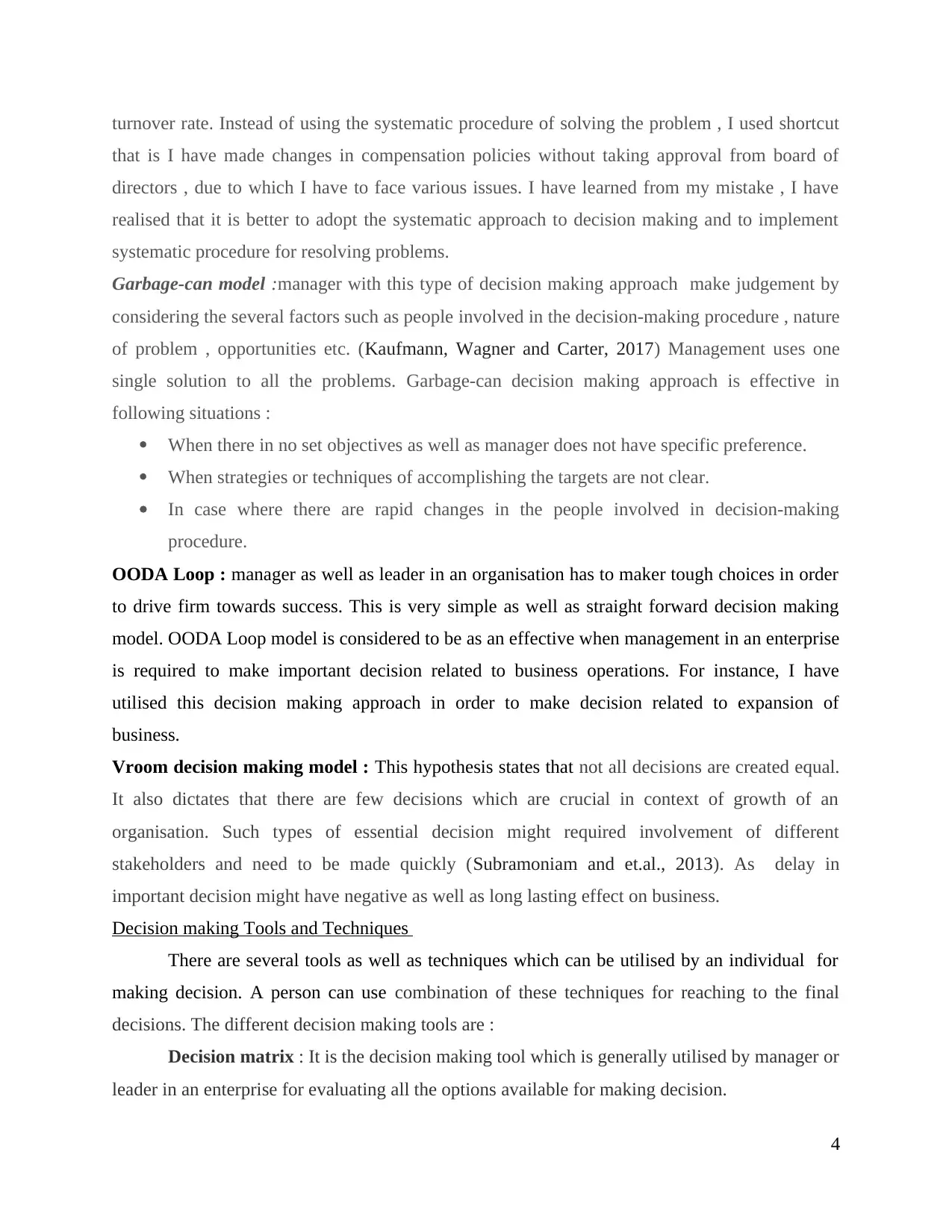
turnover rate. Instead of using the systematic procedure of solving the problem , I used shortcut
that is I have made changes in compensation policies without taking approval from board of
directors , due to which I have to face various issues. I have learned from my mistake , I have
realised that it is better to adopt the systematic approach to decision making and to implement
systematic procedure for resolving problems.
Garbage-can model :manager with this type of decision making approach make judgement by
considering the several factors such as people involved in the decision-making procedure , nature
of problem , opportunities etc. (Kaufmann, Wagner and Carter, 2017) Management uses one
single solution to all the problems. Garbage-can decision making approach is effective in
following situations :
When there in no set objectives as well as manager does not have specific preference.
When strategies or techniques of accomplishing the targets are not clear.
In case where there are rapid changes in the people involved in decision-making
procedure.
OODA Loop : manager as well as leader in an organisation has to maker tough choices in order
to drive firm towards success. This is very simple as well as straight forward decision making
model. OODA Loop model is considered to be as an effective when management in an enterprise
is required to make important decision related to business operations. For instance, I have
utilised this decision making approach in order to make decision related to expansion of
business.
Vroom decision making model : This hypothesis states that not all decisions are created equal.
It also dictates that there are few decisions which are crucial in context of growth of an
organisation. Such types of essential decision might required involvement of different
stakeholders and need to be made quickly (Subramoniam and et.al., 2013). As delay in
important decision might have negative as well as long lasting effect on business.
Decision making Tools and Techniques
There are several tools as well as techniques which can be utilised by an individual for
making decision. A person can use combination of these techniques for reaching to the final
decisions. The different decision making tools are :
Decision matrix : It is the decision making tool which is generally utilised by manager or
leader in an enterprise for evaluating all the options available for making decision.
4
that is I have made changes in compensation policies without taking approval from board of
directors , due to which I have to face various issues. I have learned from my mistake , I have
realised that it is better to adopt the systematic approach to decision making and to implement
systematic procedure for resolving problems.
Garbage-can model :manager with this type of decision making approach make judgement by
considering the several factors such as people involved in the decision-making procedure , nature
of problem , opportunities etc. (Kaufmann, Wagner and Carter, 2017) Management uses one
single solution to all the problems. Garbage-can decision making approach is effective in
following situations :
When there in no set objectives as well as manager does not have specific preference.
When strategies or techniques of accomplishing the targets are not clear.
In case where there are rapid changes in the people involved in decision-making
procedure.
OODA Loop : manager as well as leader in an organisation has to maker tough choices in order
to drive firm towards success. This is very simple as well as straight forward decision making
model. OODA Loop model is considered to be as an effective when management in an enterprise
is required to make important decision related to business operations. For instance, I have
utilised this decision making approach in order to make decision related to expansion of
business.
Vroom decision making model : This hypothesis states that not all decisions are created equal.
It also dictates that there are few decisions which are crucial in context of growth of an
organisation. Such types of essential decision might required involvement of different
stakeholders and need to be made quickly (Subramoniam and et.al., 2013). As delay in
important decision might have negative as well as long lasting effect on business.
Decision making Tools and Techniques
There are several tools as well as techniques which can be utilised by an individual for
making decision. A person can use combination of these techniques for reaching to the final
decisions. The different decision making tools are :
Decision matrix : It is the decision making tool which is generally utilised by manager or
leader in an enterprise for evaluating all the options available for making decision.
4
⊘ This is a preview!⊘
Do you want full access?
Subscribe today to unlock all pages.

Trusted by 1+ million students worldwide
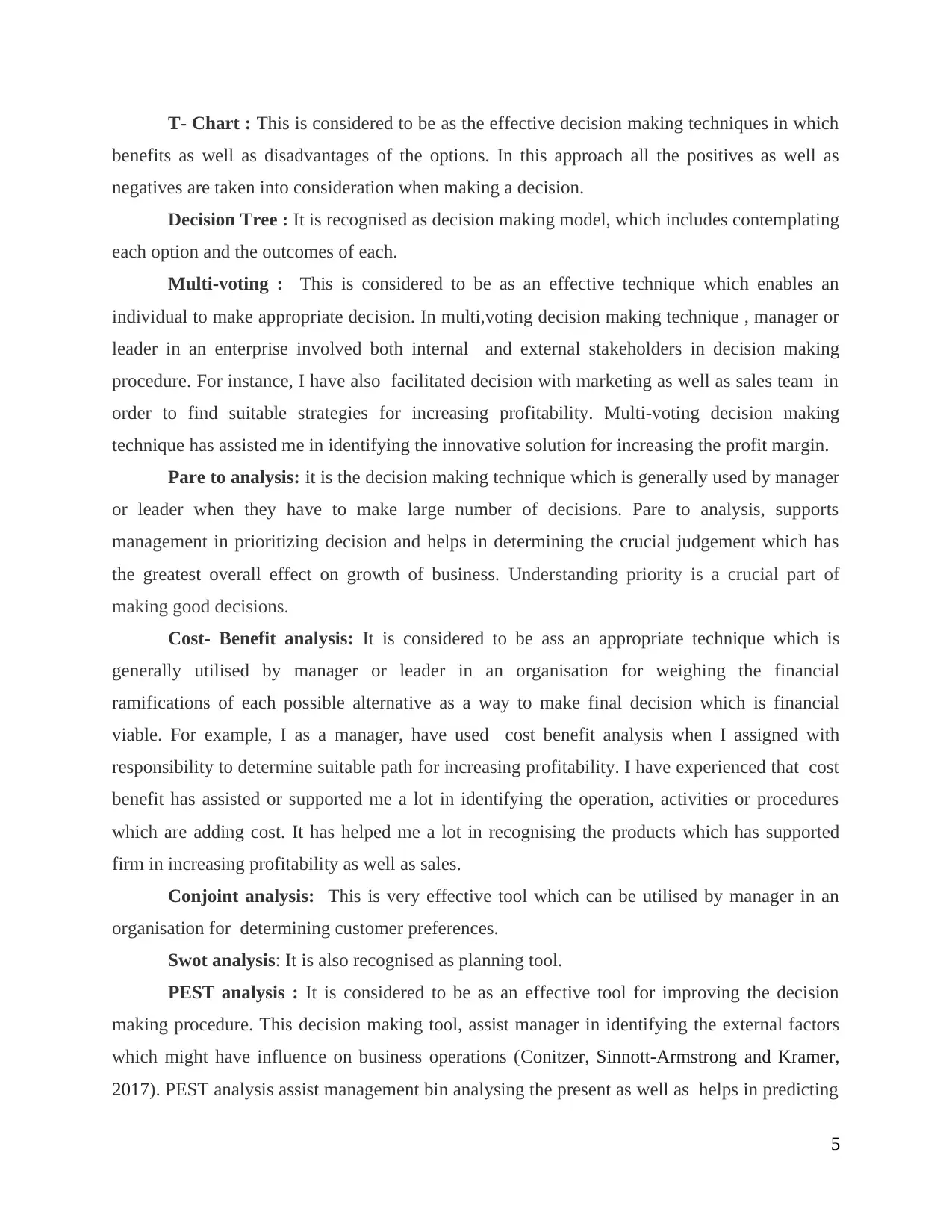
T- Chart : This is considered to be as the effective decision making techniques in which
benefits as well as disadvantages of the options. In this approach all the positives as well as
negatives are taken into consideration when making a decision.
Decision Tree : It is recognised as decision making model, which includes contemplating
each option and the outcomes of each.
Multi-voting : This is considered to be as an effective technique which enables an
individual to make appropriate decision. In multi,voting decision making technique , manager or
leader in an enterprise involved both internal and external stakeholders in decision making
procedure. For instance, I have also facilitated decision with marketing as well as sales team in
order to find suitable strategies for increasing profitability. Multi-voting decision making
technique has assisted me in identifying the innovative solution for increasing the profit margin.
Pare to analysis: it is the decision making technique which is generally used by manager
or leader when they have to make large number of decisions. Pare to analysis, supports
management in prioritizing decision and helps in determining the crucial judgement which has
the greatest overall effect on growth of business. Understanding priority is a crucial part of
making good decisions.
Cost- Benefit analysis: It is considered to be ass an appropriate technique which is
generally utilised by manager or leader in an organisation for weighing the financial
ramifications of each possible alternative as a way to make final decision which is financial
viable. For example, I as a manager, have used cost benefit analysis when I assigned with
responsibility to determine suitable path for increasing profitability. I have experienced that cost
benefit has assisted or supported me a lot in identifying the operation, activities or procedures
which are adding cost. It has helped me a lot in recognising the products which has supported
firm in increasing profitability as well as sales.
Conjoint analysis: This is very effective tool which can be utilised by manager in an
organisation for determining customer preferences.
Swot analysis: It is also recognised as planning tool.
PEST analysis : It is considered to be as an effective tool for improving the decision
making procedure. This decision making tool, assist manager in identifying the external factors
which might have influence on business operations (Conitzer, Sinnott-Armstrong and Kramer,
2017). PEST analysis assist management bin analysing the present as well as helps in predicting
5
benefits as well as disadvantages of the options. In this approach all the positives as well as
negatives are taken into consideration when making a decision.
Decision Tree : It is recognised as decision making model, which includes contemplating
each option and the outcomes of each.
Multi-voting : This is considered to be as an effective technique which enables an
individual to make appropriate decision. In multi,voting decision making technique , manager or
leader in an enterprise involved both internal and external stakeholders in decision making
procedure. For instance, I have also facilitated decision with marketing as well as sales team in
order to find suitable strategies for increasing profitability. Multi-voting decision making
technique has assisted me in identifying the innovative solution for increasing the profit margin.
Pare to analysis: it is the decision making technique which is generally used by manager
or leader when they have to make large number of decisions. Pare to analysis, supports
management in prioritizing decision and helps in determining the crucial judgement which has
the greatest overall effect on growth of business. Understanding priority is a crucial part of
making good decisions.
Cost- Benefit analysis: It is considered to be ass an appropriate technique which is
generally utilised by manager or leader in an organisation for weighing the financial
ramifications of each possible alternative as a way to make final decision which is financial
viable. For example, I as a manager, have used cost benefit analysis when I assigned with
responsibility to determine suitable path for increasing profitability. I have experienced that cost
benefit has assisted or supported me a lot in identifying the operation, activities or procedures
which are adding cost. It has helped me a lot in recognising the products which has supported
firm in increasing profitability as well as sales.
Conjoint analysis: This is very effective tool which can be utilised by manager in an
organisation for determining customer preferences.
Swot analysis: It is also recognised as planning tool.
PEST analysis : It is considered to be as an effective tool for improving the decision
making procedure. This decision making tool, assist manager in identifying the external factors
which might have influence on business operations (Conitzer, Sinnott-Armstrong and Kramer,
2017). PEST analysis assist management bin analysing the present as well as helps in predicting
5
Paraphrase This Document
Need a fresh take? Get an instant paraphrase of this document with our AI Paraphraser

the future trend. For instance, I have conducted Pestle analysis for creating the marketing plan
for an organisation. I have also executed Pestle analysis before planning to introduce new
product in the market. I have experienced that it is very effect decision making tool which has
supported me in successful launch of product.
6
for an organisation. I have also executed Pestle analysis before planning to introduce new
product in the market. I have experienced that it is very effect decision making tool which has
supported me in successful launch of product.
6
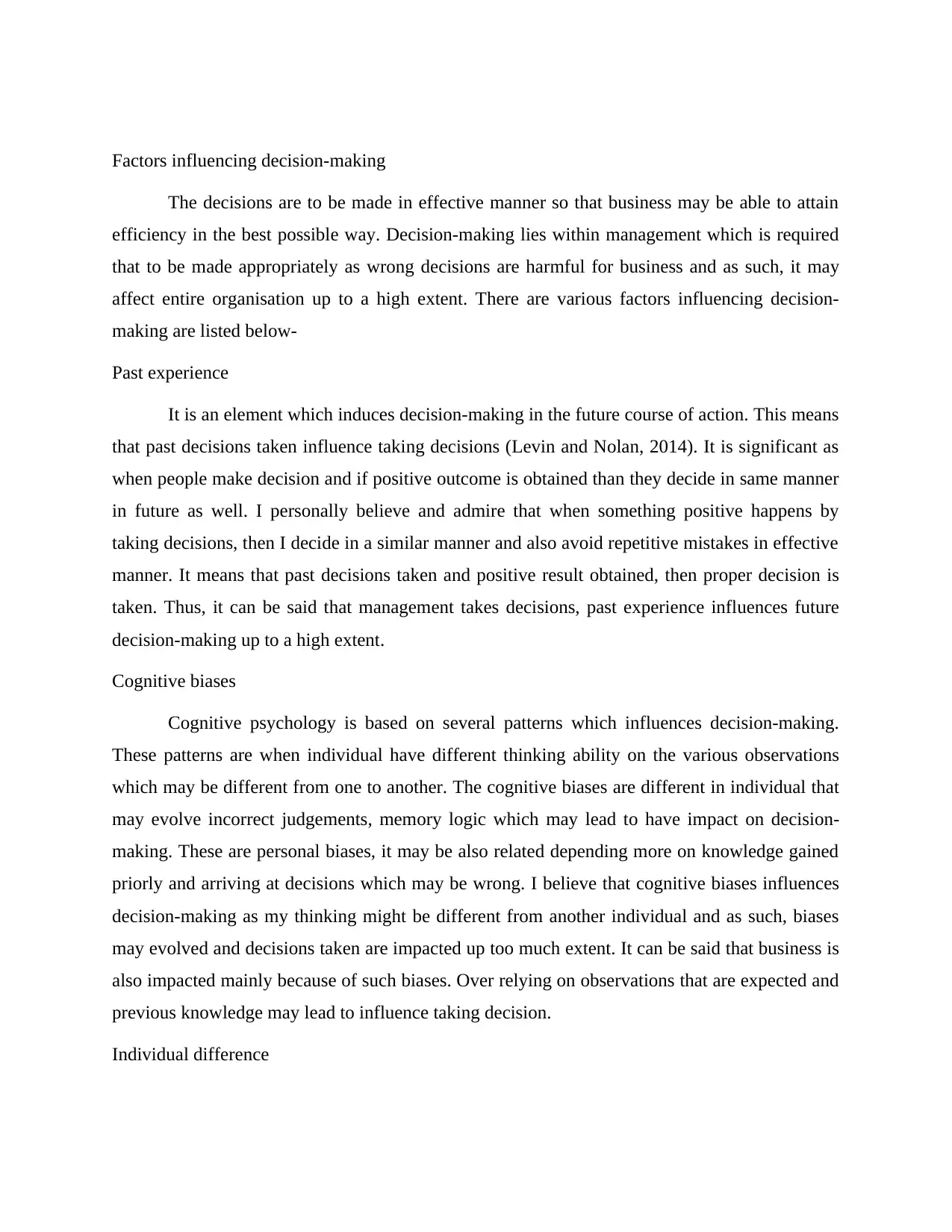
Factors influencing decision-making
The decisions are to be made in effective manner so that business may be able to attain
efficiency in the best possible way. Decision-making lies within management which is required
that to be made appropriately as wrong decisions are harmful for business and as such, it may
affect entire organisation up to a high extent. There are various factors influencing decision-
making are listed below-
Past experience
It is an element which induces decision-making in the future course of action. This means
that past decisions taken influence taking decisions (Levin and Nolan, 2014). It is significant as
when people make decision and if positive outcome is obtained than they decide in same manner
in future as well. I personally believe and admire that when something positive happens by
taking decisions, then I decide in a similar manner and also avoid repetitive mistakes in effective
manner. It means that past decisions taken and positive result obtained, then proper decision is
taken. Thus, it can be said that management takes decisions, past experience influences future
decision-making up to a high extent.
Cognitive biases
Cognitive psychology is based on several patterns which influences decision-making.
These patterns are when individual have different thinking ability on the various observations
which may be different from one to another. The cognitive biases are different in individual that
may evolve incorrect judgements, memory logic which may lead to have impact on decision-
making. These are personal biases, it may be also related depending more on knowledge gained
priorly and arriving at decisions which may be wrong. I believe that cognitive biases influences
decision-making as my thinking might be different from another individual and as such, biases
may evolved and decisions taken are impacted up too much extent. It can be said that business is
also impacted mainly because of such biases. Over relying on observations that are expected and
previous knowledge may lead to influence taking decision.
Individual difference
The decisions are to be made in effective manner so that business may be able to attain
efficiency in the best possible way. Decision-making lies within management which is required
that to be made appropriately as wrong decisions are harmful for business and as such, it may
affect entire organisation up to a high extent. There are various factors influencing decision-
making are listed below-
Past experience
It is an element which induces decision-making in the future course of action. This means
that past decisions taken influence taking decisions (Levin and Nolan, 2014). It is significant as
when people make decision and if positive outcome is obtained than they decide in same manner
in future as well. I personally believe and admire that when something positive happens by
taking decisions, then I decide in a similar manner and also avoid repetitive mistakes in effective
manner. It means that past decisions taken and positive result obtained, then proper decision is
taken. Thus, it can be said that management takes decisions, past experience influences future
decision-making up to a high extent.
Cognitive biases
Cognitive psychology is based on several patterns which influences decision-making.
These patterns are when individual have different thinking ability on the various observations
which may be different from one to another. The cognitive biases are different in individual that
may evolve incorrect judgements, memory logic which may lead to have impact on decision-
making. These are personal biases, it may be also related depending more on knowledge gained
priorly and arriving at decisions which may be wrong. I believe that cognitive biases influences
decision-making as my thinking might be different from another individual and as such, biases
may evolved and decisions taken are impacted up too much extent. It can be said that business is
also impacted mainly because of such biases. Over relying on observations that are expected and
previous knowledge may lead to influence taking decision.
Individual difference
⊘ This is a preview!⊘
Do you want full access?
Subscribe today to unlock all pages.

Trusted by 1+ million students worldwide
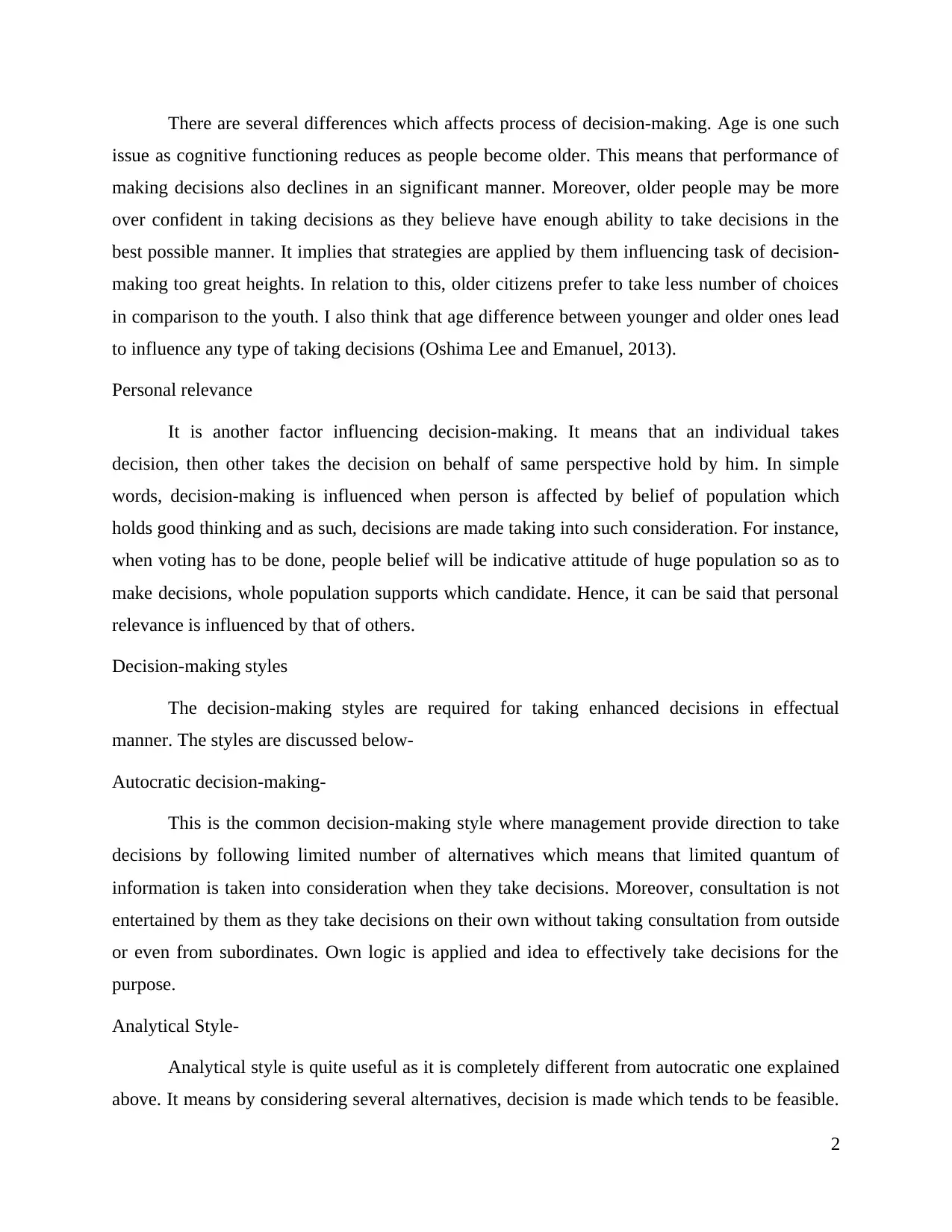
There are several differences which affects process of decision-making. Age is one such
issue as cognitive functioning reduces as people become older. This means that performance of
making decisions also declines in an significant manner. Moreover, older people may be more
over confident in taking decisions as they believe have enough ability to take decisions in the
best possible manner. It implies that strategies are applied by them influencing task of decision-
making too great heights. In relation to this, older citizens prefer to take less number of choices
in comparison to the youth. I also think that age difference between younger and older ones lead
to influence any type of taking decisions (Oshima Lee and Emanuel, 2013).
Personal relevance
It is another factor influencing decision-making. It means that an individual takes
decision, then other takes the decision on behalf of same perspective hold by him. In simple
words, decision-making is influenced when person is affected by belief of population which
holds good thinking and as such, decisions are made taking into such consideration. For instance,
when voting has to be done, people belief will be indicative attitude of huge population so as to
make decisions, whole population supports which candidate. Hence, it can be said that personal
relevance is influenced by that of others.
Decision-making styles
The decision-making styles are required for taking enhanced decisions in effectual
manner. The styles are discussed below-
Autocratic decision-making-
This is the common decision-making style where management provide direction to take
decisions by following limited number of alternatives which means that limited quantum of
information is taken into consideration when they take decisions. Moreover, consultation is not
entertained by them as they take decisions on their own without taking consultation from outside
or even from subordinates. Own logic is applied and idea to effectively take decisions for the
purpose.
Analytical Style-
Analytical style is quite useful as it is completely different from autocratic one explained
above. It means by considering several alternatives, decision is made which tends to be feasible.
2
issue as cognitive functioning reduces as people become older. This means that performance of
making decisions also declines in an significant manner. Moreover, older people may be more
over confident in taking decisions as they believe have enough ability to take decisions in the
best possible manner. It implies that strategies are applied by them influencing task of decision-
making too great heights. In relation to this, older citizens prefer to take less number of choices
in comparison to the youth. I also think that age difference between younger and older ones lead
to influence any type of taking decisions (Oshima Lee and Emanuel, 2013).
Personal relevance
It is another factor influencing decision-making. It means that an individual takes
decision, then other takes the decision on behalf of same perspective hold by him. In simple
words, decision-making is influenced when person is affected by belief of population which
holds good thinking and as such, decisions are made taking into such consideration. For instance,
when voting has to be done, people belief will be indicative attitude of huge population so as to
make decisions, whole population supports which candidate. Hence, it can be said that personal
relevance is influenced by that of others.
Decision-making styles
The decision-making styles are required for taking enhanced decisions in effectual
manner. The styles are discussed below-
Autocratic decision-making-
This is the common decision-making style where management provide direction to take
decisions by following limited number of alternatives which means that limited quantum of
information is taken into consideration when they take decisions. Moreover, consultation is not
entertained by them as they take decisions on their own without taking consultation from outside
or even from subordinates. Own logic is applied and idea to effectively take decisions for the
purpose.
Analytical Style-
Analytical style is quite useful as it is completely different from autocratic one explained
above. It means by considering several alternatives, decision is made which tends to be feasible.
2
Paraphrase This Document
Need a fresh take? Get an instant paraphrase of this document with our AI Paraphraser
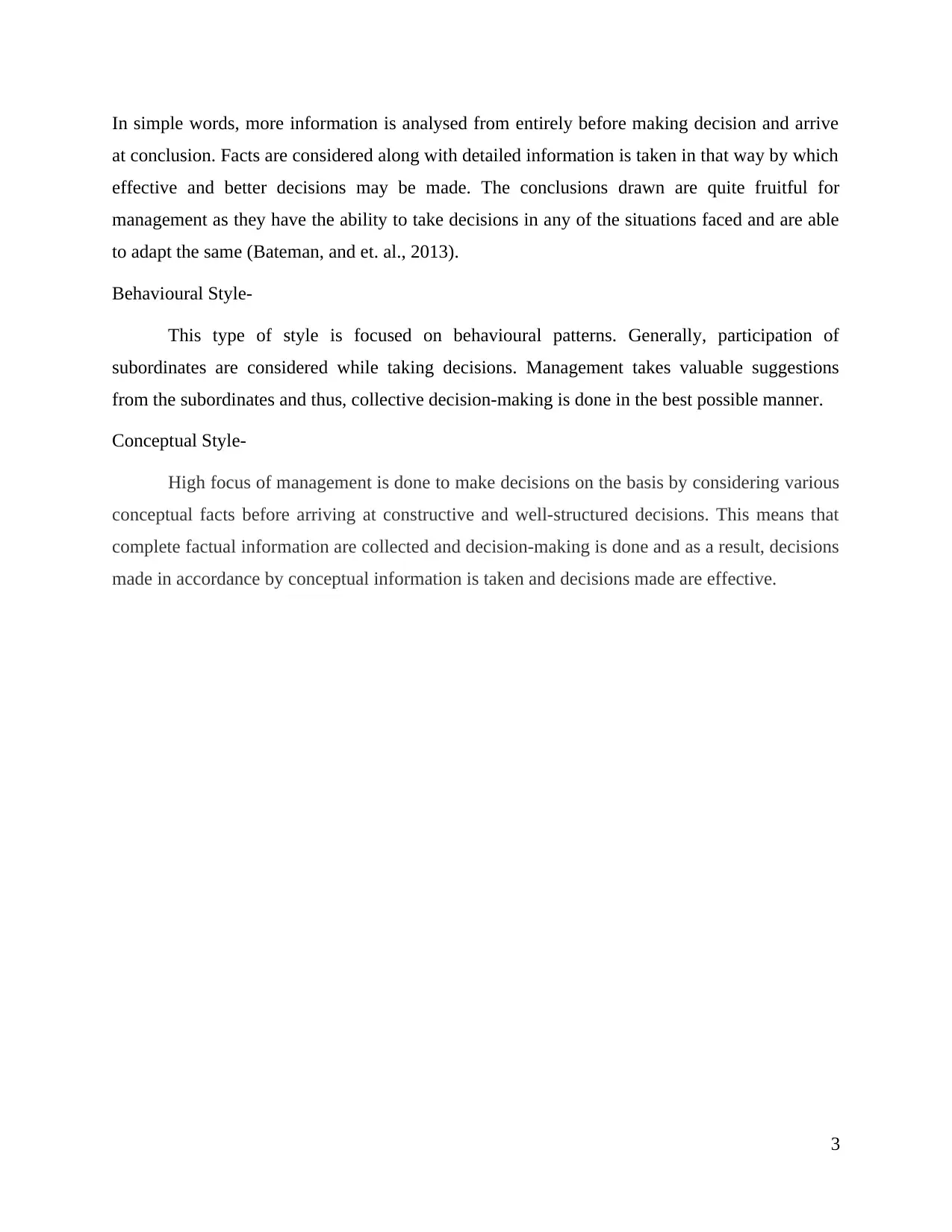
In simple words, more information is analysed from entirely before making decision and arrive
at conclusion. Facts are considered along with detailed information is taken in that way by which
effective and better decisions may be made. The conclusions drawn are quite fruitful for
management as they have the ability to take decisions in any of the situations faced and are able
to adapt the same (Bateman, and et. al., 2013).
Behavioural Style-
This type of style is focused on behavioural patterns. Generally, participation of
subordinates are considered while taking decisions. Management takes valuable suggestions
from the subordinates and thus, collective decision-making is done in the best possible manner.
Conceptual Style-
High focus of management is done to make decisions on the basis by considering various
conceptual facts before arriving at constructive and well-structured decisions. This means that
complete factual information are collected and decision-making is done and as a result, decisions
made in accordance by conceptual information is taken and decisions made are effective.
3
at conclusion. Facts are considered along with detailed information is taken in that way by which
effective and better decisions may be made. The conclusions drawn are quite fruitful for
management as they have the ability to take decisions in any of the situations faced and are able
to adapt the same (Bateman, and et. al., 2013).
Behavioural Style-
This type of style is focused on behavioural patterns. Generally, participation of
subordinates are considered while taking decisions. Management takes valuable suggestions
from the subordinates and thus, collective decision-making is done in the best possible manner.
Conceptual Style-
High focus of management is done to make decisions on the basis by considering various
conceptual facts before arriving at constructive and well-structured decisions. This means that
complete factual information are collected and decision-making is done and as a result, decisions
made in accordance by conceptual information is taken and decisions made are effective.
3
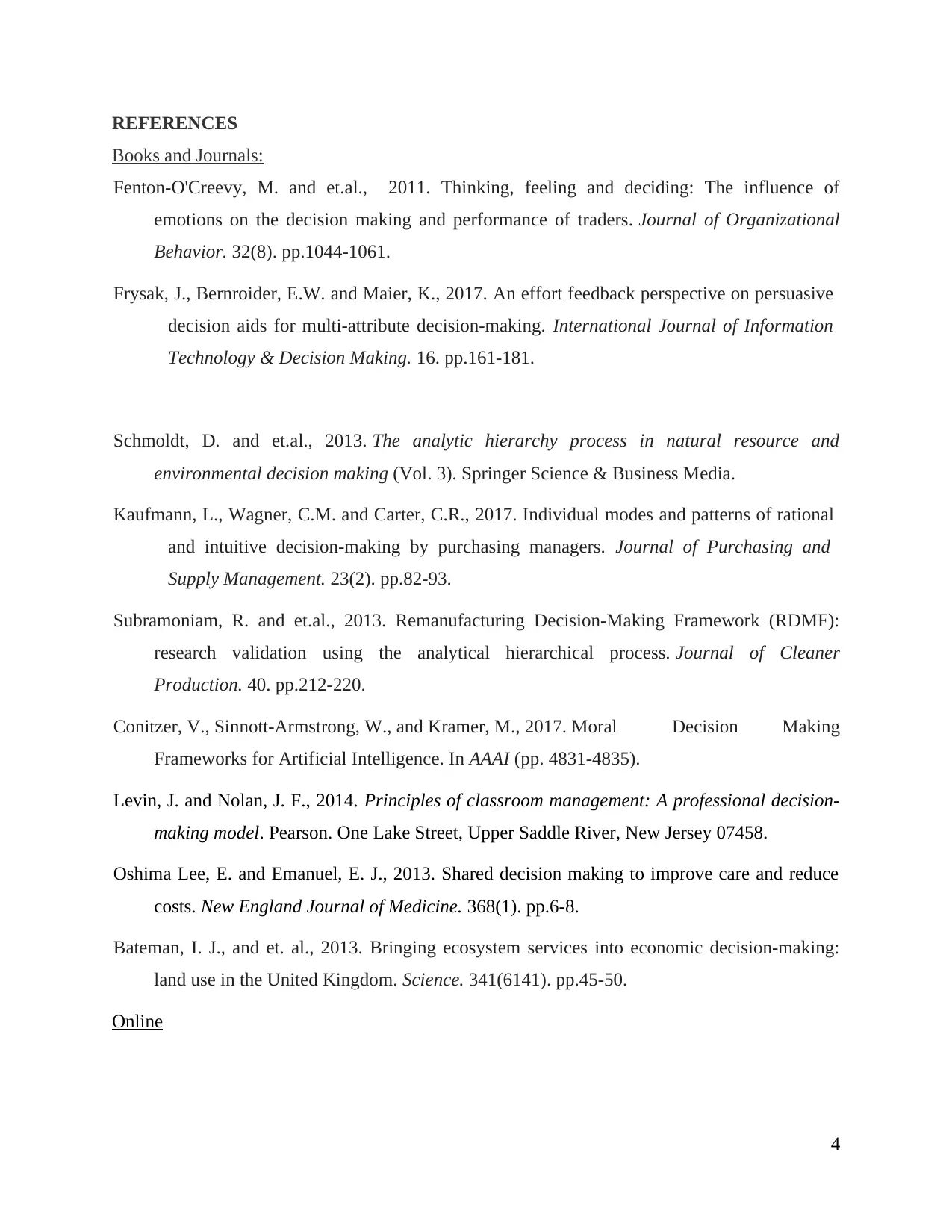
REFERENCES
Books and Journals:
Fenton‐O'Creevy, M. and et.al., 2011. Thinking, feeling and deciding: The influence of
emotions on the decision making and performance of traders. Journal of Organizational
Behavior. 32(8). pp.1044-1061.
Frysak, J., Bernroider, E.W. and Maier, K., 2017. An effort feedback perspective on persuasive
decision aids for multi-attribute decision-making. International Journal of Information
Technology & Decision Making. 16. pp.161-181.
Schmoldt, D. and et.al., 2013. The analytic hierarchy process in natural resource and
environmental decision making (Vol. 3). Springer Science & Business Media.
Kaufmann, L., Wagner, C.M. and Carter, C.R., 2017. Individual modes and patterns of rational
and intuitive decision-making by purchasing managers. Journal of Purchasing and
Supply Management. 23(2). pp.82-93.
Subramoniam, R. and et.al., 2013. Remanufacturing Decision-Making Framework (RDMF):
research validation using the analytical hierarchical process. Journal of Cleaner
Production. 40. pp.212-220.
Conitzer, V., Sinnott-Armstrong, W., and Kramer, M., 2017. Moral Decision Making
Frameworks for Artificial Intelligence. In AAAI (pp. 4831-4835).
Levin, J. and Nolan, J. F., 2014. Principles of classroom management: A professional decision-
making model. Pearson. One Lake Street, Upper Saddle River, New Jersey 07458.
Oshima Lee, E. and Emanuel, E. J., 2013. Shared decision making to improve care and reduce
costs. New England Journal of Medicine. 368(1). pp.6-8.
Bateman, I. J., and et. al., 2013. Bringing ecosystem services into economic decision-making:
land use in the United Kingdom. Science. 341(6141). pp.45-50.
Online
4
Books and Journals:
Fenton‐O'Creevy, M. and et.al., 2011. Thinking, feeling and deciding: The influence of
emotions on the decision making and performance of traders. Journal of Organizational
Behavior. 32(8). pp.1044-1061.
Frysak, J., Bernroider, E.W. and Maier, K., 2017. An effort feedback perspective on persuasive
decision aids for multi-attribute decision-making. International Journal of Information
Technology & Decision Making. 16. pp.161-181.
Schmoldt, D. and et.al., 2013. The analytic hierarchy process in natural resource and
environmental decision making (Vol. 3). Springer Science & Business Media.
Kaufmann, L., Wagner, C.M. and Carter, C.R., 2017. Individual modes and patterns of rational
and intuitive decision-making by purchasing managers. Journal of Purchasing and
Supply Management. 23(2). pp.82-93.
Subramoniam, R. and et.al., 2013. Remanufacturing Decision-Making Framework (RDMF):
research validation using the analytical hierarchical process. Journal of Cleaner
Production. 40. pp.212-220.
Conitzer, V., Sinnott-Armstrong, W., and Kramer, M., 2017. Moral Decision Making
Frameworks for Artificial Intelligence. In AAAI (pp. 4831-4835).
Levin, J. and Nolan, J. F., 2014. Principles of classroom management: A professional decision-
making model. Pearson. One Lake Street, Upper Saddle River, New Jersey 07458.
Oshima Lee, E. and Emanuel, E. J., 2013. Shared decision making to improve care and reduce
costs. New England Journal of Medicine. 368(1). pp.6-8.
Bateman, I. J., and et. al., 2013. Bringing ecosystem services into economic decision-making:
land use in the United Kingdom. Science. 341(6141). pp.45-50.
Online
4
⊘ This is a preview!⊘
Do you want full access?
Subscribe today to unlock all pages.

Trusted by 1+ million students worldwide
1 out of 13
Related Documents
Your All-in-One AI-Powered Toolkit for Academic Success.
+13062052269
info@desklib.com
Available 24*7 on WhatsApp / Email
![[object Object]](/_next/static/media/star-bottom.7253800d.svg)
Unlock your academic potential
Copyright © 2020–2025 A2Z Services. All Rights Reserved. Developed and managed by ZUCOL.





